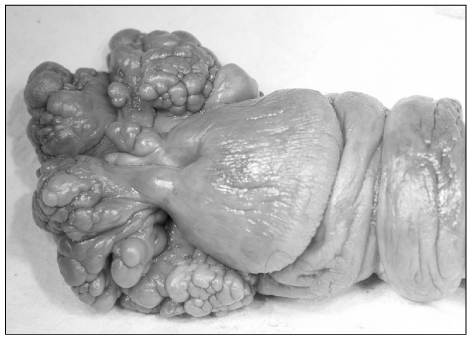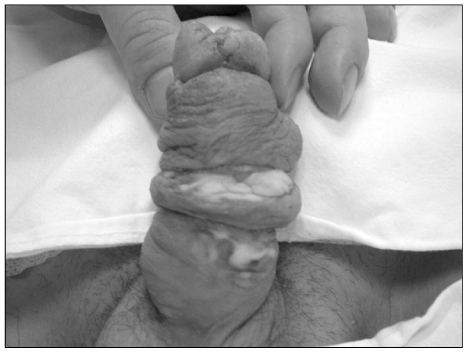Korean J Urol.
2009 Jun;50(6):619-621. 10.4111/kju.2009.50.6.619.
Giant Fibroepithelial Polyp of the Glans Penis
- Affiliations
-
- 1Department of Urology, College of Medicine, Soonchunhyang University, Bucheon, Korea. urojun@schbc.ac.kr
- 2Department of Pathology, College of Medicine, Soonchunhyang University, Bucheon, Korea.
- KMID: 1989798
- DOI: http://doi.org/10.4111/kju.2009.50.6.619
Abstract
- Fibroepithelial polyps are a benign neoplasm of mesodermal origin that usually occur in the urinary tract. However, a giant fibroepithelial polyp of the glans penis is very rare and is strongly linked with long-term condom catheter use. In this article, we report a case of a 45-year-old man who presented with a giant fibroepithelial polyp originating from the glans penis. Physical examination showed a 6x3 cm sized mass lesion overlying the ventral surface of the glans near the urethral meatus without urethral communication. For the previous 10 years, the patient had been required to use a condom catheter secondary to paraplegia sustained during a T12-L1 spinal cord injury. He was successfully treated by wide local excision of the mass and suprapubic cystostomy placement. There was no evidence of recurrence after 12 months of follow-up.
Keyword
MeSH Terms
Figure
Reference
-
1. Ahn JW, Rho JH, Kim YS, Hong SJ, Lee MS. A case of giant ureteral polyp. Korean J Urol. 1994. 35:906–908.2. Williams TR, Wagner BJ, Corse WR, Vestevich JC. Fibroepithelial polyps of the urinary tract. Abdom Imaging. 2002. 27:217–221.3. Fetsch JF, Davis CJ Jr, Hallman JR, Chung LS, Lupton GP, Sesterhenn IA. Lymphedematous fibroepithelial polyps of the glans penis and prepuce: a clinicopathologic study of 7 cases demonstrating a strong association with chronic condom catheter use. Hum Pathol. 2004. 35:190–195.4. Yildirim I, Irkilata C, Sumer F, Aydur E, Ozcan A, Dayanc M. Fibroepithelial polyp originating from the glans penis in a child. Int J Urol. 2004. 11:187–188.5. Golji H. Complication of external condom drainage. Paraplegia. 1981. 19:189–197.6. Jayachandran S, Mooppan UM, Kim H. Complications from external (condom) urinary drainage devices. Urology. 1985. 25:31–34.7. Peña KB, Parada DD. Lymphedematous fibroepithelial polyp of the glans penis non-associated with condom catheter use. APMIS. 2008. 116:215–218.8. Orosz Z, Lehoczky O, Szoke J, Pulay T. Recurrent giant fibroepithelial stromal polyp of the vulva associated with congenital lymphedema. Gynecol Oncol. 2005. 98:168–171.9. Groisman GM, Polak-Charcon S. Fibroepithelial polyps of the anus: a histologic, immunohistochemical, and ultrastructural study, including comparison with the normal anal subepithelial layer. Am J Surg Pathol. 1998. 22:70–76.10. al-Nafussi AI, Rebello G, Hughes D, Blessing K. Benign vaginal polyp: a histological, histochemical and immunohistochemical study of 20 polyps with comparison to normal vaginal subepithelial layer. Histopathology. 1992. 20:145–150.
- Full Text Links
- Actions
-
Cited
- CITED
-
- Close
- Share
- Similar articles
-
- Giant Fibroepithelial Polyp in the Renal Pelvis to the Upper Ureter
- Congenital Fibroepithelial Polyp of the Penoscrotal Junction
- A case of giant fibroepithelial polyp of the vulva
- A Prominently Large Glans penis as a Possible sign of Benign Prostatic Hyperplasia
- A Case of Apocrine Hidrocystoma of the Glans Penis




